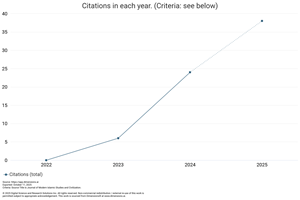Legal Analysis of Daughters' Inheritance Mahjub Siblings According to Ibn Abbas
DOI:
https://doi.org/10.59653/jmisc.v3i02.1538Keywords:
Daughters’ Inheritance, Mahjub, SiblingsAbstract
In the decision of the Panel of Judges with Case Number 247/Pdt.P/2020/PA.Smd, only the wife and daughter of the Heir are entitled to inherit the inheritance. The Heir's brothers and sisters are hindered from inheriting by the daughter. Meanwhile, this provision differs from the provisions in fiqh, which do not mention siblings who may inherit together with daughters. This study aimed to analyze the decision of the Samarinda Religious Court in case Number 247/Pdt.P/2020/PA.Smd and to find out why the Judge took the opinion of Ibn 'Abbas and overruled the opinions of other Ulama. This study uses a qualitative research method with a normative legal approach. The study results explain that the Panel of Judges determined case no. 247/Pdt.P/2020/PA.Smd concerning the determination of heirs where a daughter obstructs the inheritance rights of a sibling of the Heir, referring to the Supreme Court Jurisprudence Number 86 K/AG/1994, as well as inheritance provisions concerning the principle of hijab-mahjub in Book II Revised Edition 2013, which contains the legal principle "a daughter may obstruct the inheritance rights of a sibling of the heir", based on the opinion of Ibn 'Abbas. However, the Panel of Judges did not fully understand Ibn 'Abbas' opinion because, according to Ibn 'Abbas, a daughter may obstruct the inheritance rights of a female heir, but he does not make the daughter close the rights of a male heir as an heir.
Downloads
References
Abu Al-Fida Isma’il bin ‘Umar bin Katsir al-Quraisyi al-Dimasyiqi. Tafsir Al-Qur’an al-‘Adzim. Juz 2.
Adelina Nasution. (2017). Reinterpretasi Makna Walad Dalam Kewarisan Cucu Ditinjau Dari Persfektif Ushul Fiqh. Jurnal Jurispridensi IAIN Langsa, IX (1). 1-22. https://journal.iainlangsa.ac.id/index.php/jurisprudensi/article/view/353.
Akhmad Haries. (2019). Hukum Kewarisan Islam. Yogyakarta: Ar-Ruzz Media.
Akhter, R. (2022). Denying the Daughters: A Cross-National Study of Factors that Impact Women’s Right to Inheritance. International Journal of Interdisciplinary Social and Community Studies, 18(1). https://doi.org/10.18848/2324-7576/CGP/v18i01/33-49
Amalia, E. A. (2020). PENYETARAAN GENDER DALAM HAL PEMBAGIAN WARISAN. Ahkam: Jurnal Hukum Islam, 8(2). https://doi.org/10.21274/ahkam.2020.8.2.213-232
Amir Syarifuddin. (2015). Hukum Kewarisan Islam. Jakarta: Kencana.
Euis Nurlaelawati. (2012). Menuju Kesetaraan dalam Aturan Kewarisan Islam Indonesia: Kedudukan Anak Perempuan Versus Saudara Kandung. Indo-Islamika. 2 (1), 75-90, doi:10.1548/idi.v2i1.1653.
Hazairin. (1968). Hukum Kekeluargaan Nasional. Jakarta: Tintamas.
Holden, L., & Chaudhary, A. (2013). Daughters’ inheritance, legal pluralism, and governance in Pakistan. Journal of Legal Pluralism and Unofficial Law, 45(1). https://doi.org/10.1080/07329113.2013.781447
Mualifah, M., Ridwan, R., & Faisal, M. (2021). AHLI WARIS TUNGGAL PEREMPUAN MENURUT HUKUM WARIS ISLAM (ANALISIS PUTUSAN AGAMA MATARAM). JURNAL SOSIAL EKONOMI DAN HUMANIORA, 7(2). https://doi.org/10.29303/jseh.v7i2.37
Muhammad Abrar Pratama. (2018). Kedudukan Saudara Perempuan Kandung Pewaris Dalam Kewarisan Dengan Adanya Anak Perempuan Pewaris Menurut Hukum Waris Islam (Analisis Penetapan Pengadilan Agama Binjai Nomor 10/Pdt.P/2014.PA-BJI). Thesis. Fakultas Hukum Universitas Muhammadiyah Sumatra Utara, Medan.
Muhammad Ahmad Isawi. (2009). Tafsir Ibnu Mas’ud: Studi Tentang Ibnu Mas’ud dan Tafsirnya, terj. Ali Murtadho Syahudi. Jakarta: Pustaka Azzam.
Nurul Khairiyah Ritonga. (2019). Anak Perempuan Menghijab Paman Sebagai Pewaris (Analisis Putusan PA No. 008/Pdt/2014/PA/Mbl. Muara Bulian, Jambi). Thesis. Universitas Islam Negeri Sumatera Utara Medan.
Raja Sitonga et al. (2022). Praktek Hijab-Mahjub dalam Kewarisan Islam Menurut Konsep Syajaratul Mirats. Tahkim, 5 (1), March 2022. 21-42. doi: https://doi.org/10.29313/tahkim.v5i1.9437
Satria Efendi. (2004). Problematika Hukum Keluarga Islam Kontemporer. Jakarta: Kencana.
Syahrul Mubarak Subeitan. Ketentuan Waris dan Problematikanya Pada Masyarakat Muslim Indonesia. Al-Mujtahid. 1 (2). 2021. 113-124. doi: http://journal.iain-manado.ac.id/index.php/almujtahid
Syaikh Muhammad bin Shalih al-'Utsaimin. (n.d.) Petunjuk Praktis Hukum Waris : Menurut Al-Qur-an dan As-Sunnah Yang Shahih. Jakarta Timur : Pustaka Ibnu Katsir
Umi Sakinah. (2014). Analisis Pendapat Ibnu Abbas Tentang Makna Walad dan Implikasinya Terhadap Kewarisan Saudara bersama Anak dalam Proses Legislasi Nasional. Thesis. Universitas Islam Negeri Walisongo. Semarang.
Vatuk, S. (2022). Muslim daughters and inheritance in India: Sharīcat, custom and practice. Contemporary South Asia, 30(1). https://doi.org/10.1080/09584935.2021.2021854
Wahbah al-Zuẖailiy. (n.d.). al-Fiqh al-Islâmî wa Adillatuh, Beirut: Dār al-Fikr. Juz. 6.
Zulpahmi Lubis dan M. Nur Husein Daulay. (2024). Alternatif Solusi Terhadap Permasalahan Waris Saudara Laki-laki yang Mewarisi bersama dengan Anak Perempuan. Al-Usrah. 11 (3), Juni 2024, 18-34. doi:http://dx.doi.org/10.30821/al-usrah.v11i2.19164)
Downloads
Published
How to Cite
Issue
Section
License
Copyright (c) 2025 Latifatul Fajriyyah, Muhammad Maulana

This work is licensed under a Creative Commons Attribution-ShareAlike 4.0 International License.
Authors who publish with this journal agree to the following terms:
- Authors retain copyright and grant the journal right of first publication with the work simultaneously licensed under a Creative Commons Attribution-ShareAlike that allows others to share the work with an acknowledgement of the work's authorship and initial publication in this journal.
- Authors are able to enter into separate, additional contractual arrangements for the non-exclusive distribution of the journal's published version of the work (e.g., post it to an institutional repository or publish it in a book), with an acknowledgement of its initial publication in this journal.
- Authors are permitted and encouraged to post their work online (e.g., in institutional repositories or on their website) prior to and during the submission process, as it can lead to productive exchanges, as well as earlier and greater citation of published work (See The Effect of Open Access).
























